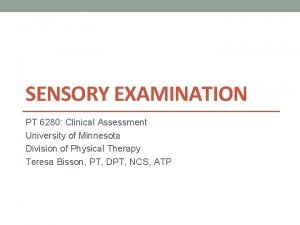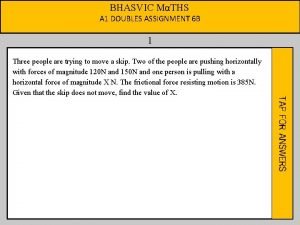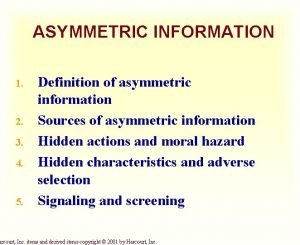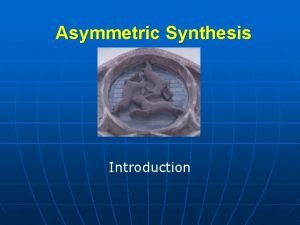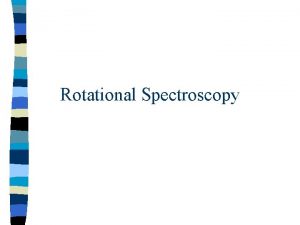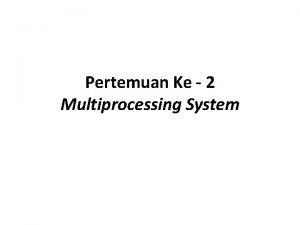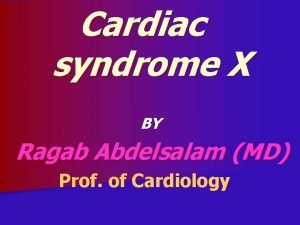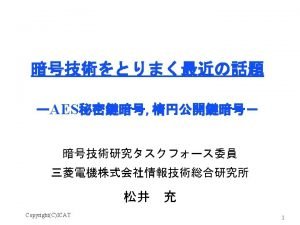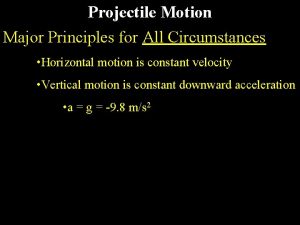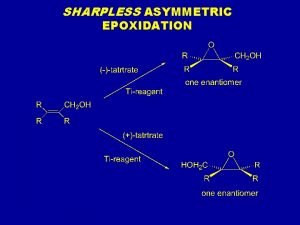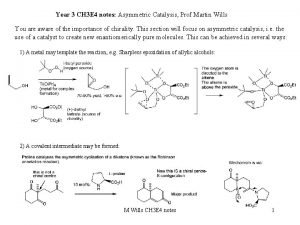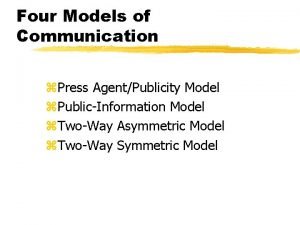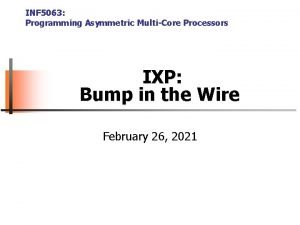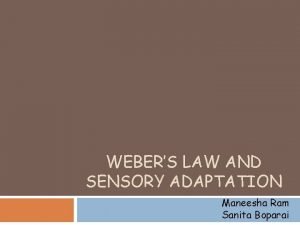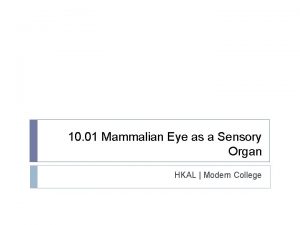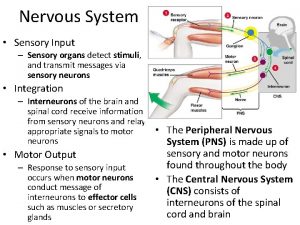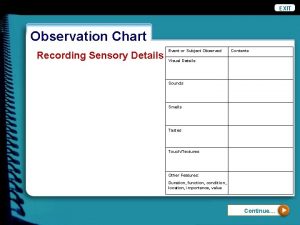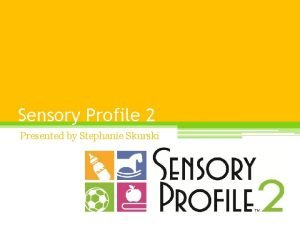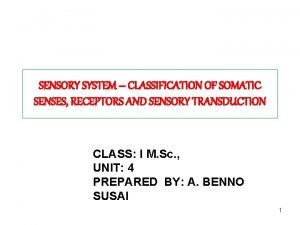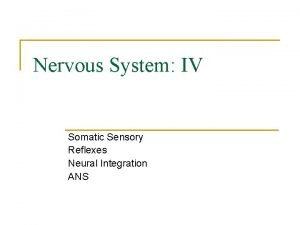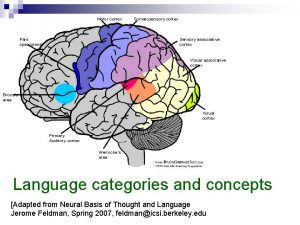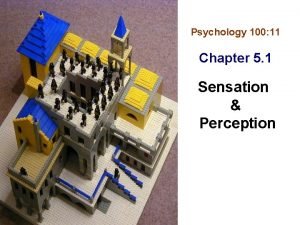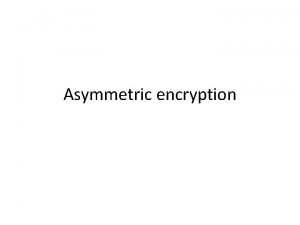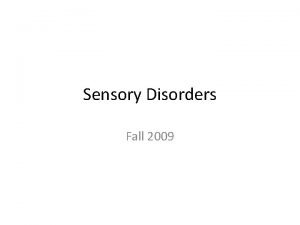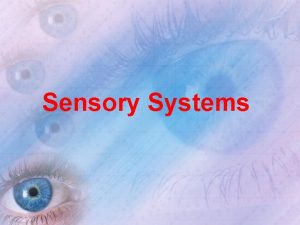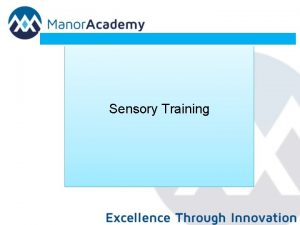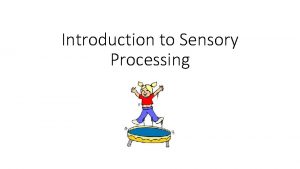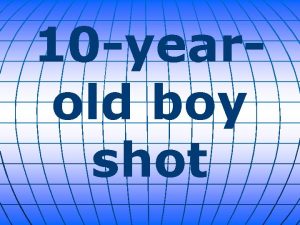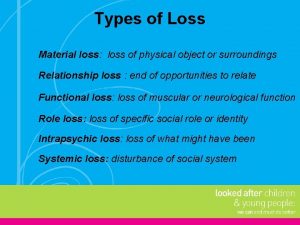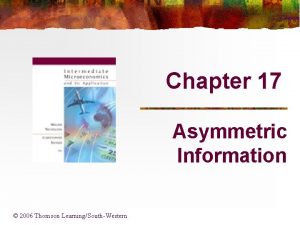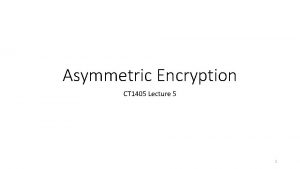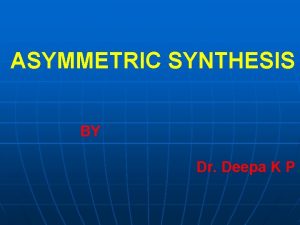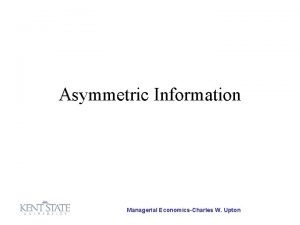A 52 yearold woman with asymmetric sensory loss






















































- Slides: 54



A 52 -year-old woman with asymmetric sensory loss and paresthesias in both arms and legs and impaired dexterity • 5 months earlier: hands and feet gradually began to feel as “wrapped tightly in bandages” • 2. 5 months earlier: difficulty with fine motor control, recognizing objects by feel in hands • 1 month earlier: sensation of imbalance when closing her eyes, felt unstable while walking, numbness and tingling in hands and arms, intermittent shooting pain in the hands • The symptoms progressed proximally in the right arm and left leg and affected the left arm and right leg in a milder fashion, also increased in severity • Stiffness in her hands, worse in the morning Chad et al, N Engl J Med, 2011

A 52 -year-old woman with asymmetric sensory loss and paresthesias in both arms and legs and impaired dexterity • 3 years earlier: episodes (for weeks) of numbness and tingling over the shoulders • On examination at that time: • Patchy loss of sensation of pinprick in the arms that did not conform to a dermatomal pattern, loss of pinprick sensation on the back • MRI of the spine with contrast: normal • No treatment was prescribed, and the symptoms resolved Chad et al, N Engl J Med, 2011

A 52 -year-old woman with asymmetric sensory loss and paresthesias in both arms and legs and impaired dexterity • Mild Raynaud's phenomenon for years, with no digital ulceration • Worked in an office • 25 -pack-year smoking, alcohol in moderation, no use of illicit drugs or exposure to metals, toxins, or large doses of vitamin supplements • Her brother and sister: ulcerative colitis, her sister: myasthenia gravis Chad et al, N Engl J Med, 2011

A 52 -year-old woman with asymmetric sensory loss and paresthesias in both arms and legs and impaired dexterity • Esophagogastroduodenoscopy: mild gastritis but otherwise normal • CXR and contrast-CT of abdomen and pelvis: normal • CBC, chemistry panel (including serum electrolytes), TSH, CRP: normal • ANA: positive (titer unknown) • Rheumatoid factor: 381 IU per milliliter (normal value, <30) • ESR: 65 mm per hour (normal rate, <20) • B 12: normal. • Borrelia burgdorferi antibodies: negative Chad et al, N Engl J Med, 2011

A 52 -year-old woman with asymmetric sensory loss and paresthesias in both arms and legs and impaired dexterity • Blood pressure 100/75 mm Hg, pulse 90 beats/minute while sitting (no orthostatic change) • Muscle tone and strength: normal • Successive hand tapping on a table and finger tapping of the index finger on the interphalangeal joint of the thumb: slightly slowed on the right side • Gait: normal; Romberg: swayed slightly; required support with tandem walking; able to walk on heels/toes • Sensory examination: • Vibration: severely diminished in fingers and forearm on the right, and less severely diminished on the left, absent in the left great toe and right great toe, severely reduced at the left ankle and nearly normal at the right ankle • Joint position: severely impaired at the interphalangeal joint of the right thumb, intact on the left • Difficulty identifying coins with either hand when eyes closed • Pinprick : diminished throughout the arms and legs but present on trunk Chad et al, N Engl J Med, 2011

A 52 -year-old woman with asymmetric sensory loss and paresthesias in both arms and legs and impaired dexterity • Summary: • Diffuse, progressive sensory disorder for 5 months (arms >legs) • Tightness, pins and needles (paresthesias), “shooting pains”: positive sensory symptoms (spontaneous discharges from sensory nerves) • Loss of feeling in hands and feet, inability to recognize objects by feel, diminished dexterity, poor balance: negative sensory symptoms (loss of sensory-nerve function) Chad et al, N Engl J Med, 2011

A 52 -year-old woman with asymmetric sensory loss and paresthesias in both arms and legs and impaired dexterity • 1) Where is the lesion? • 2) What is the lesion?

Subdivisions of the nervous system a) Central NS (brain and spinal cord) b) Peripheral NS (cranial and spinal nerves)

Posterior Column–Medial Lemniscal Pathway

Anterolateral Pathways

Regions of Sensory Innervation Supplied by Cutaneous Nerve Branches

Dermatomes

Cellular Organization of the Peripheral Nervous System Chad DA et al. N Engl J Med 2011; 364: 1856 -1865.

Sensory Neuron Fiber Types

A 52 -year-old woman with asymmetric sensory loss and paresthesias in both arms and legs and impaired dexterity • Sensory loss from dysfunction of both large and small nerve fibers • Sensory deficits: bilateral and asymmetric (hands > feet, R>L) • Loss of tendon reflexes: asymmetric • Despite reported weakness, muscle atrophy and reduced strength were absent (subjective sense of weakness from impairment in proprioception) • No evidence of dysautonomia (e. g. orthostatic hypotension) • neuropathy, not length-dependent Chad et al, N Engl J Med, 2011

Electrophysiological testing

Nerve Conduction Study (Ulnar Nerve, motor)

A 52 -year-old woman with asymmetric sensory loss and paresthesias in both arms and legs and impaired dexterity Chad et al, N Engl J Med, 2011

Neuroimaging studies

A 52 -year-old woman with asymmetric sensory loss and paresthesias in both arms and legs and impaired dexterity Chad et al, N Engl J Med, 2011

A 52 -year-old woman with asymmetric sensory loss and paresthesias in both arms and legs and impaired dexterity • Abnormal T 2 signal in spinal cord (especially posteriorly): • • • Subacute combined degeneration Demyelinating conditions (multiple sclerosis) Transverse myelitis Tabes dorsalis Myelopathies associated with HIV Sarcoidosis Connective-tissue disorder Cord infarction Dorsal-root ganglionopathy with secondary involvement of the posterior columns Chad et al, N Engl J Med, 2011

A 52 -year-old woman with asymmetric sensory loss and paresthesias in both arms and legs and impaired dexterity • Dorsal-root ganglionopathy with secondary involvement of the posterior columns • Toxic neuronopathy (e. g. cisplatin or pyridoxine at mega levels) • Paraneoplastic sensory neuronopathy (acute-days to subacute-months asymmetric onset, 90% small-cell lung carcinomas, in 80% of these anti. Hu positive) • Neuronopathy associated with Sjögren's syndrome Chad et al, N Engl J Med, 2011

A 52 -year-old woman with asymmetric sensory loss and paresthesias in both arms and legs and impaired dexterity Telangiectasias (that blanched with pressure and refilled within seconds) over the nasal bridge (Panel A), on the lips (Panel B), and on the fingers (Panel C). Chad et al, N Engl J Med, 2011

A 52 -year-old woman with asymmetric sensory loss and paresthesias in both arms and legs and impaired dexterity • • • Dorsal-root ganglionopathy Positive tests for ANA and rheumatoid factor, elevated ESR Raynaud's phenomenon: relatively mild No history of sicca symptoms, rash, or arthralgias Complete serologic evaluation: • ANA assay (immunofluorescence on HEp-2 cells): classic speckled pattern • Strongly positive anti-Ro antibodies (57. 30 optical-density [OD] units; reference value, <19. 99) (Sjögren's syndrome but also occurs in systemic lupus erythematosus, inflammatory muscle disease, systemic sclerosis, and overlapping connective-tissue diseases) • Rheumatologic diagnosis: overlap syndrome, with features of Sjögren's syndrome and limited systemic sclerosis Chad et al, N Engl J Med, 2011

A 52 -year-old woman with asymmetric sensory loss and paresthesias in both arms and legs and impaired dexterity • Treatment approach: halt damage to the dorsal-root ganglia as quickly as possible • 6 -month course of prednisone beginning at 60 mg per day, oral cyclophosphamide (100 mg per day) for 6 months, rituximab (1000 mg intravenously in two doses, 15 days apart), and pneumocystis prophylaxis • Anti-Ro antibody titer became negative (0. 71 OD units) • Follow-up electrodiagnostic studies 1 year after: slight increase in the amplitude of the left radial and left sural responses • Pain: little response to gabapentin, good response to pregabalin but with unacceptable side effects, currently nortriptyline and lamotrigine, with hydrocodone for breakthrough pain Chad et al, N Engl J Med, 2011

A 27 -Year-Old Woman with Pain and Swelling of the Legs • 5 months earlier: swelling of her ankles and lower legs (varied in severity from day to day, not affected by position) • 6 weeks later: awakened by burning and stinging pain on the dorsal aspect of left foot • The paresthesia improved with naproxen • 2 weeks later: pain recurred and involved both feet, with increased swelling of ankles and legs; a rash developed over her feet and toes and a 10 -day course of dicloxacillin for presumed cellulitis was given • 2 weeks later: spironolactone was prescribed and swelling of legs and ankles improved • However, the pain persisted, even after administration of NSAIDs, elevation, and icing, interfered with sleep • 3 months later: referred to neurology Vallat J et al. N Engl J Med 2007; 356: 1252 -1259.

A 27 -Year-Old Woman with Pain and Swelling of the Legs • Depression and hypothyroidism diagnosed 4 -5 years earlier • Mild iron-deficiency anemia • Medications: levothyroxine, fluoxetine, iron supplement, ibuprofen, spironolactone, and tramadol • She did not abuse alcohol or drugs • No family history of neurologic disease Vallat J et al. N Engl J Med 2007; 356: 1252 -1259.

A 27 -Year-Old Woman with Pain and Swelling of the Legs • Weight 159. 1 kg, height 173 cm • Tense edema of the ankles and legs. • Skin over the lateral aspects of feet: dry and scaling with a diffuse purpuric rash and a few petechiae on the anterior legs and dorsal aspects of the feet (L>R) • Pain on light touch over the lateral aspects of both feet • Motor strength, deep-tendon reflexes and plantar responses: normal in both arms and legs • Reduced sensation to pinprick and vibration in the fourth and fifth toes bilaterally, worse on the left • Romberg test negative, tandem gait normal Vallat J et al. N Engl J Med 2007; 356: 1252 -1259.

A 27 -Year-Old Woman with Pain and Swelling of the Legs • Normal levels of blood glucose after an overnight fast, TSH, B 12, folate, and ACE. • Tests negative for ANCA; RPR; rapid plasma reagin; cryoprotein; serum immunofixation; Lyme antibody; hepatitis B and C antibody; HIV antibody; anti–double-stranded DNA, anti-La, anti. Smith, anti-RNP, and anti–Scl-70 antibodies; and anticardiolipin antibodies. Vallat J et al. N Engl J Med 2007; 356: 1252 -1259.

A 27 -Year-Old Woman with Pain and Swelling of the Legs • Electrophysiological studies: • • Absent bilateral sural and superficial peroneal sensory potentials Median and ulnar sensory-nerve action potentials: normal in the left arm Motor-conduction studies in the arms and legs: normal Needle electromyogram: no abnormality in the gastrocnemius, tibialis anterior, or paraspinal muscles, fibrillations and positive sharp waves in the flexor hallucis brevis bilaterally (evidence for a length-dependent symmetric axonal polyneuropathy affecting both motor and sensory fibers) Vallat J et al. N Engl J Med 2007; 356: 1252 -1259.

A 27 -Year-Old Woman with Pain and Swelling of the Legs In Summary: • Peripheral neuropathy, with acute onset, associated swelling of ankles and legs, cutaneous lesions • Signs asymmetrical at onset and located in the lower legs in the distribution of the sural and superficial peroneal nerves bilaterally (sensation to pinprick and vibration reduced in the fourth and fifth toes bilaterally) • No ataxia and present deep-tendon reflexes: ganglionopathy (neuronopathy) ruled out • sensorimotor multiple mononeuropathy (mononeuropathy multiplex) affecting large and small myelinated fibers Vallat J et al. N Engl J Med 2007; 356: 1252 -1259.

A 27 -Year-Old Woman with Pain and Swelling of the Legs • Predominantly sensory multiple mononeuropathy • • Sarcoidosis Malignant tumors Infections (retroviruses, leprosy, hepatitis, Lyme disease) Vasculitic neuropathy (infarctions of the nerve fascicles multifocal acute axonal lesions as a result of multiple small-vessel occlusions due to inflammation, and in some cases, fibrinoid necrosis within the walls of the vasa nervorum) Vallat J et al. N Engl J Med 2007; 356: 1252 -1259.

A 27 -Year-Old Woman with Pain and Swelling of the Legs Vallat J et al. N Engl J Med 2007; 356: 1252 -1259.

A 27 -Year-Old Woman with Pain and Swelling of the Legs • Biopsy of the left sural nerve to confirm the presence of axonal lesions induced by vasculitis • Salivary-gland biopsy to rule out Sjögren's syndrome ( mild periductal lymphoplasmacytic infiltrate that did not meet the criteria) Vallat J et al. N Engl J Med 2007; 356: 1252 -1259.

A 27 -Year-Old Woman with Pain and Swelling of the Legs Vallat J et al. N Engl J Med 2007; 356: 1252 -1259. Biopsy Specimen of the Sural Nerve

A 27 -Year-Old Woman with Pain and Swelling of the Legs • Axonal neuropathy due to lymphoplasmacytic small-vessel vasculitis, associated with connective-tissue disease with features of Sjögren's syndrome • Prednisone to 60 mg a day, for about 6 weeks, then gradually tapered and stopped over the period of 1 year • 6 years after the diagnosis: increasing symptoms of dry eyes and dry mouth, recurrent edema of the lower legs ( hydroxychloroquine), no evidence of neuropathy Vallat J et al. N Engl J Med 2007; 356: 1252 -1259.


Pathological processes affecting peripheral nerves 1. 2. 3. 4. Wallerian degeneration due to axon interruption Axonal degeneration (axonopathy) Neuronal degeneration (neuronopathy) Segmental demyelination (myelinopathy)

2. Axonal degeneration

3. Sensory neuronopathy

4. Segmental demyelination


Connective tissue diseases and peripheral neuropathies • Vasculitic neuropathy • Distal axonal polyneuropathy • Compression neuropathy • Sensory neuronopathy • Trigeminal sensory neuropathy • Acute or chronic demyelinating polyneuropathy • Plexopathy

Rheumatoid arthritis Peripheral neuropathy in 1% to 10%, although EDX evidence may be found in up to 57% (Agarwal et l, 2008) (1) compression neuropathies (e. g. carpal tunel), often found with early disease and caused by periarticular inflammation and fibrosis (2) Chronic distal symmetrical sensory polyneuropathy, possibly related to occlusive vasculopathy (dysesthesias, paresthesias, and loss of sensation in a patchy stocking-glove distribution) (3) mononeuropathy or multiple mononeuropathies (vasculitis) (4) Severe fulminating sensorimotor polyneuropathy (vasculitis) (5) Neuropathies caused by treatments

Rheumatoid arthritis • Compression neuropathies: treatment includes splints, local corticosteroids, or surgical decompression • Chronic symmetrical, predominantly sensory polyneuropathy: prognosis is generally good, no specific treatment is recommended

Rheumatoid arthritis • Systemic vasculitis: severe chronic rheumatoid arthritis with poor prognosis (severe joint deformities, rheumatoid nodules, and cutaneous vasculitic lesions) • Rheumatoid vasculitis: frequently cause of vasculitic neuropathy (rheumatoid arthritis is a common disorder, affecting 2% to 5% of the general population) • Acute mononeuropathy, multiple mononeuropathies, distal symmetrical sensorimotor polyneuropathy • Treatment: high-dose prednisone and cyclophosphamide

Systemic Lupus Erythematosus • Peripheral neuropathy in 6% to 21% of patients – Symmetrical subacute or chronic axonal polyneuropathy with predominant sensory symptoms most common – Mononeuropathies, brachial plexopathy, and GBS or CIDP occasionally – Sural nerve biopsy: perivascular inflammatory cell infiltration, only occasionally definite vasculitis • Polyneuropathy associated with SLE resulting in significant disability: immunosuppressive treatment (proven vasculitis: plasmapheresis, prednisone, and cyclophosphamide)

Sjögren Syndrome • Peripheral nerve involvement occurs in 10% to 32% (up to 62%) of patients with primary Sjögren syndrome, has a strong predilection for women and may precede and overshadow the sicca symptoms, being the major presenting complaint • Presentations: – Distal symmetrical sensory neuropathy with mixed large- and small-fiber deficits (most common) – Sensorimotor neuropathy – Small-fiber neuropathy – Polyradiculoneuropathy – Multiple mononeuropathies – Painful dorsal root ganglionopathy – Trigeminal sensory neuropathy – Sensory ataxic neuronopathy – Autonomic neuropathy

Sjögren Syndrome • Reduced or absent SNAPs and normal or only mildly abnormal motor conduction studies • Sensory ganglionopathy: high-intensity lesions of the posterior columns on T 2 -weighted MRI of the cervical cord • Sural nerve biopsy: nonspecific perivascular lymphocytic infiltrates together with diffuse decrease in myelinated fibers • Vasculitis: rarely, in patients with multiple mononeuropathies

Sjögren Syndrome • Treatment recommendations: small retrospective uncontrolled series or individual case reports • Most report improvement with corticosteroids, either alone or in combination with immunosuppressants, neutralizing antibodies to TNF-α, or IVIG

Conclusions • Peripheral neuropathy a common occurrence in connective tissue disorders • Can precede the systemic manifestations of rheumatic disease • High degree of clinical suspicion and clinical and other testing can provide the diagnosis • Timely treatment essential for favorable long term prognosis

 Cortical sensations
Cortical sensations The human ability to speedily recognize familiar objects
The human ability to speedily recognize familiar objects Once upon a time there lived an old woman
Once upon a time there lived an old woman Face recognition
Face recognition A woman travels in a lift. the mass of the woman is 50 kg
A woman travels in a lift. the mass of the woman is 50 kg Normal loss treatment in process costing
Normal loss treatment in process costing Projection bias
Projection bias Asymmetric information diagram
Asymmetric information diagram Strategic view of ihrm
Strategic view of ihrm Symmetric encryption advantages and disadvantages
Symmetric encryption advantages and disadvantages Asymmetric bandwidth
Asymmetric bandwidth Asymmetric synthesis example
Asymmetric synthesis example Selection rule for raman spectroscopy
Selection rule for raman spectroscopy Key distribution
Key distribution Asymmetric information game theory
Asymmetric information game theory Multiprocessing adalah
Multiprocessing adalah How much does diltiazem lower blood pressure
How much does diltiazem lower blood pressure Asymmetric communication
Asymmetric communication Asymmetric encryption 歴史
Asymmetric encryption 歴史 Symmetric and asymmetric matrix
Symmetric and asymmetric matrix Asymmetric dominance effect
Asymmetric dominance effect Asymmetric key authentication
Asymmetric key authentication Asymmetric encryption java
Asymmetric encryption java Asymmetric vlan
Asymmetric vlan Asymmetric vlan
Asymmetric vlan Asymmetric parabola
Asymmetric parabola Inter vlan routing教學
Inter vlan routing教學 Introduction to corporate communication
Introduction to corporate communication Sharpless asymmetric epoxidation
Sharpless asymmetric epoxidation Asymmetric synthesis notes
Asymmetric synthesis notes Two way asymmetrical model example
Two way asymmetrical model example Asymmetric information diagram
Asymmetric information diagram Id vlan (7-4094)
Id vlan (7-4094) Asymmetric multicore processing
Asymmetric multicore processing Asymmetric key cryptography
Asymmetric key cryptography Asymmetric vlan
Asymmetric vlan Obstructed labour
Obstructed labour Symmetric vs asymmetric encryption performance
Symmetric vs asymmetric encryption performance Whorled antennae
Whorled antennae Sensory adaptation example
Sensory adaptation example Sensory attachment intervention training
Sensory attachment intervention training Sequence of sensory processing
Sequence of sensory processing Extrinsic muscles of the tongue
Extrinsic muscles of the tongue Incoming sensory impulses and outgoing motor impulses
Incoming sensory impulses and outgoing motor impulses Tina champagne trauma informed care
Tina champagne trauma informed care Organs of the sensory system
Organs of the sensory system Spinal cord structure
Spinal cord structure Sensory observation chart
Sensory observation chart Striate cortex
Striate cortex Sensory profile 2
Sensory profile 2 Classification of somatic senses
Classification of somatic senses Proprioception autism
Proprioception autism Thermoreceptors def
Thermoreceptors def Cortex meaning
Cortex meaning Sensory experience
Sensory experience
